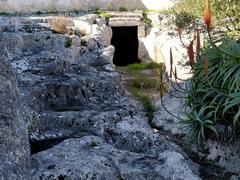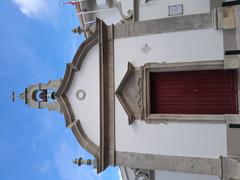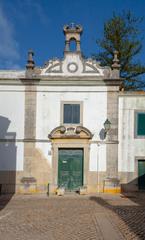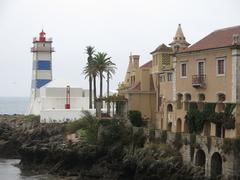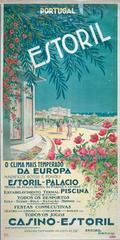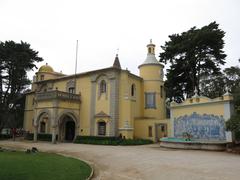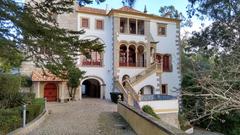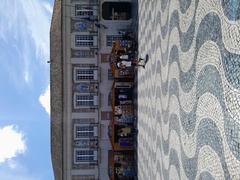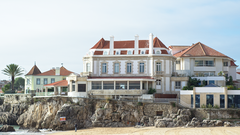Casa Lencastre, Estoril, Portugal: Visiting Hours, Tickets, and Tourist Guide
Date: 14/06/2025
Introduction
Casa Lencastre in Estoril, Portugal, is a significant emblem of the country’s aristocratic and architectural heritage. Rooted in the noble lineage of the English House of Lancaster, the Lencastre family established a prominent presence in Portugal through royal connections and ducal titles, such as those of Aveiro and Abrantes. The villa stands out for its unique blend of neomanueline, neo-gothic, and Moorish architectural styles, making it an essential stop for those interested in the intersection of history, culture, and design on the Portuguese Riviera.
This comprehensive guide presents Casa Lencastre’s historical significance, visitor information, travel tips, and nearby attractions to help you plan an enriching visit. For further details, consult resources such as Cascais Cultura, Dukes and Princes, and BestGuide.pt.
Table of Contents
- Historical Legacy of Casa Lencastre
- Visitor Information
- Architectural Significance
- Nearby Attractions
- FAQs
- Casa António Lencastre in Cascais
- Summary and Recommendations
- References
Historical Legacy of Casa Lencastre
Casa Lencastre is deeply entwined with the history of Anglo-Portuguese nobility. The Lencastre family, tracing its roots to the English House of Lancaster, gained influence in Portugal through strategic royal marriages and the acquisition of prominent titles. Their legacy is evident in numerous estates and mansions along the Lisbon coast, including the Palace of Santos in Lisbon (now the French Embassy), and in summer residences across the Estoril and Cascais region.
While several original Lencastre properties now serve governmental or private functions, Casa Lencastre in Estoril remains a visible and celebrated monument, reflecting both the family’s heritage and the region’s transformation into a cosmopolitan retreat during the late 19th and early 20th centuries (Dukes and Princes).
Visitor Information
Visiting Hours & Entry
Casa Lencastre is a private residence and does not allow public access to its interior. However, its exterior can be freely admired from Rua Frederico Arouca at any time. Occasionally, guided walking tours offered by local tourism offices and cultural organizations include Casa Lencastre among their stops, providing historical context and architectural insights.
- Hours: Exterior viewing is available at all times; interior access is not permitted.
- Tickets: No tickets are required for exterior viewing. Guided tours that include Casa Lencastre may charge a fee and often require advance booking.
- Guided Tours: Check with Cascais and Estoril tourism offices for special events or thematic tours that feature Casa Lencastre or related historic sites (Estoril Portugal).
Accessibility
The area around Casa Lencastre is generally accessible, with paved sidewalks and pedestrian-friendly routes. However, as with many historic districts, some streets may be uneven or slightly inclined. Visitors with mobility challenges should consult local resources for recommended accessible paths.
Travel Tips & Best Times to Visit
- When to Visit: Spring and early autumn offer the most pleasant weather and fewer crowds. Cultural events and festivals are common during these periods.
- Getting There: Estoril is easily reached by train from Lisbon and Cascais. The villa is a short walk from the Estoril train station or nearby bus stops.
- What to Wear: Comfortable walking shoes are recommended due to cobblestone streets. Bring sun protection, especially in summer.
Architectural Significance
Casa Lencastre exemplifies the eclectic summer architecture of the Portuguese Riviera, blending styles popular among the elite in the early 20th century.
Exterior Features
- Distinctive Yellow Roof: The villa’s yellow-tiled roof is a local landmark and a favorite subject for photographers.
- Ornate Stonework: The façade is adorned with neomanueline and neo-gothic motifs, including heraldic coats of arms that emphasize the family’s noble origins.
- Tower and Turrets: A prominent tower anchors the structure, typical of the period’s summer residences.
Interior Highlights
The villa’s interior is not open to the public, but historical records note:
- Azulejaria: Decorative tiles from the 17th and 18th centuries depicting family emblems.
- Painted Ceilings and Grand Staircase: Artistic and artisanal features reflecting the tastes of Portugal’s upper class at the turn of the century (Cascais Cultura).
Cultural Importance
Casa Lencastre is listed as a Monument of Municipal Interest, underscoring its value to local heritage and its role in Estoril’s social and cultural evolution (Cascais Cultura).
Nearby Attractions
While in Estoril, visitors can explore:
- Estoril Casino: One of Europe’s largest casinos and a historic entertainment venue.
- Scenic Beaches: Praia do Tamariz and Praia da Conceição are nearby.
- Historic Gardens and Chapels: Such as the Jardim da Casa de Telmo Pereira and local churches.
- Museums: Museum of Portuguese Music, Casa Verdades de Faria, and others in the Cascais area.
For more on the region’s attractions, visit Estoril Portugal and BestGuide.pt.
FAQs
Q: Can I visit the interior of Casa Lencastre?
A: No, the villa is a private residence. Only the exterior can be viewed from the street.
Q: Are guided tours available?
A: Occasionally, local walking tours include Casa Lencastre as an exterior highlight. Check with local tourism offices for current offerings.
Q: Is the site wheelchair accessible?
A: The surrounding area is generally accessible, but some streets may be uneven.
Q: Are tickets required?
A: No tickets are required to view the exterior. Guided tours may require advance booking and a fee.
Q: What else can I see nearby?
A: Estoril Casino, coastal promenades, historic gardens, and several museums are all within easy reach.
Casa António Lencastre in Cascais
Location & Access
Casa António Lencastre, another notable villa, is located at R. Frederico Arouca, n.º 107A, in central Cascais, within walking distance from the train station (Portugal Please). The area is easily accessible by public transport, taxi, or on foot.
Visiting Hours & Tours
- Access: The villa remains a private residence. The exterior is visible from public areas at any time.
- Guided Tours: Some historical walking tours include Casa António Lencastre as a featured stop. Advance booking is recommended for special tours.
Tips & Accessibility
- Best Season: Late spring and early summer (June) offer mild weather and long daylight hours (Wanderlog).
- What to Bring: Comfortable shoes, sun protection, and a camera for photographs of the villa’s Italianate façade.
- Accessibility: Most streets are paved, though some may be hilly or uneven. Contact the local tourism office for accessible route guidance.
- Nearby Amenities: Cafés, restaurants, and shops are plentiful in Cascais. The area is safe and welcoming for tourists (Estoril Portugal; Portugal Visitor).
Summary and Recommendations
Casa Lencastre in Estoril epitomizes the region’s aristocratic charm, architectural diversity, and cultural significance. While interior access is not possible, its striking exterior, historical context, and proximity to other landmarks make it a rewarding stop for visitors. The best times to visit are spring and autumn, when weather and cultural activities are at their peak.
Combine your visit with walks along the Estoril promenade, a stop at the casino, and exploration of nearby Cascais. Download the Audiala app for self-guided tours and insider information, and follow local tourism channels for updates.
References
- Casa Lencastre in Estoril: Visiting Hours, Tickets, and Historical Significance for Visitors, 2025
- Casa Lencastre Estoril: Visiting Hours, Tickets, and Architectural Highlights, 2025, Cascais Cultura
- Casa António Lencastre Visiting Hours, Tickets, and Guide to Cascais Historical Sites, 2025, Portugal Please
- Estoril Portugal Official Tourism Website, 2025
- BestGuide.pt: A Journey Through Estoril’s History, 2025
- Wanderlog: Estoril in June
- Portugal Visitor: Estoril Cascais Guide
For further details, consult the official Cascais cultural heritage portal, historical overviews at Dukes and Princes, and visitor information at Estoril Portugal.
